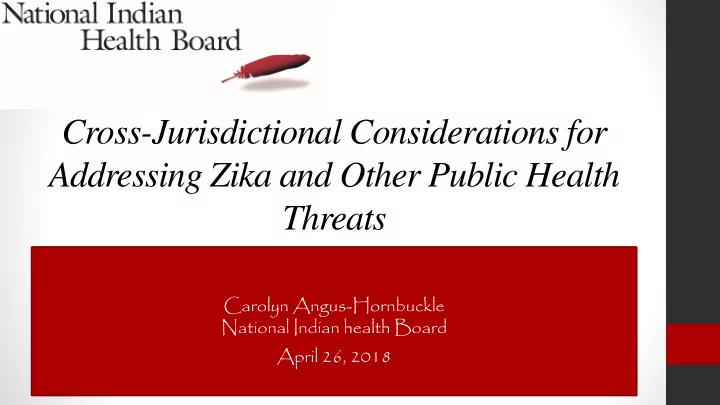

Cross-Jurisdictional Considerations for Addressing Zika and Other Public Health Threats (Name) (N me) (Tit (T itle le) Carolyn Angus-Hornbuckle Nati tional nal India ian n Health lth Board rd National Indian health Board (E (Eve vent nt Name) e) April 26, 2018 (Date) (D te)
The National Indian Health Board Purpose: To advocate on behalf of all federally recognized American Indian and Alaska Native Tribes to ensure the fulfillment of the trust responsibility to deliver health and public health services as assured through treaties, and reaffirmed in legislation, executive orders and Supreme Court cases. Mission Statement: One Voice affirming and empowering American Indian and Alaska Native Peoples to protect and improve health and reduce health disparities .
The National Indian Health Board • Serves and advocates on behalf of 573 federally recognized Tribes • Works with ~ 300 Tribal Health Departments • Works with Area Regional Organizations/ Health Boards to better serve all federally recognized Tribes
The National Indian Health Board
Public Health Work in Indian Country Federal Government Roles • IHS and Tribes- primary National Indian health care providers • Organizations Tribes- provide public • State and county (NIHB) health services and are health 1st responders Area Indian • departments- National & Regional Health Boards / role and Tribal Orgs- support, TECs involvement in help build capacity, Tribal public surveillance • health varies Entire federal government has a trust TRIBES responsibility to Tribes
Reasons to foster State – Tribal Relations Common • Responsibility to deliver PH services and ensure health of citizens interests • Authority to exercise police powers, Similar which encompass public health status authorities • Avoid duplication of services; ensure Leveraging tailored responses that will work in Resources communities
Compelling Reasons for Tribes to Engage with States • Tribes can negotiate with states to Sovereignty provide services and determine appropriate programs • Increase decision making in planning Input and implementation of programs that serve AI/AN people • Complicated and confusing Jurisdiction jurisdictional issues can be negotiated before a crisis
Compelling Reasons for States to Engage with Tribes • Tribal citizens are entitled to the rights Duty and benefits of state (and federal) citizens Increased • Working with Tribes can allow state resources to get to hard to reach areas reach especially in extremely rural areas Increased • Tribes can administer programs that are culturally tailored and appropriate efficacy
Persistent Barriers • Lack of understanding regarding Tribes as governments with authority and responsibility for Tribal citizens • Lack of understanding regarding Tribal capacities (which can vary greatly) • Complicated, sometimes unclear jurisdiction
Persistent Barriers • Lack of trust • Relationships between state and Tribal leaders and staff can be lacking or adversarial • Tribes may be reluctant to engage with states because of fear it will diminish government – to- government relationship with the federal government
Strategies to Foster Partnerships Education Relationship building Ongoing communications Process & Implementing collaboration Building institutional mechanisms
Education • Tribes are sovereign governments and have inherent public health authority • States have multi-layered state bureaucracy – education to navigate that bureaucracy can help • States need to learn about the assets, needs and priorities of Tribes (by meeting people where they, many of these aspects can be understood) • Many differences and variations in Tribal Nations and communities
Relationship Building • Recognizing the need to overcome mistrust and troubled histories • Relationships need to be built before a crisis occurs • Need for in-person meetings, especially when forming relationships • Need to commit adequate staffing and resources (and recognize that turnover may be an issue) • Need for internal coordination at the Tribe or state
Communications • Need to communicate regularly for situational awareness • Need for ongoing and dedicated forums that can foster information sharing • Sharing information about resources available will ensure the resources flow to all citizens • Tribes can provide unique perspectives and solutions • Tribes are in the best position to share information with their citizens • Other Tribal Organizations can assist in the flow of information to Tribes • Dear Tribal leader letters
Process • Planning should always include Tribes (ensure feedback from Tribes before programs are developed) • Track activities and commitments • Conduct regular review and assessment of policies and programs related to state-tribal relations and provision of services • Gather recommendations for improvement • Implementing – have understanding and agreement of how work will flow, triggering events, responsibilities, etc.
Building Institutional Mechanisms Creates certainty, stability and sustainability, especially in times of political transition. Some essential, best and promising approaches include: • Authorizing legislation (and appropriations) to allow for: agreements between states, their operating divisions, and Tribes (contracts, MOUs, or MOA) • Committees or commissions or offices to carry out state-tribal affairs • Tribal liaison positions
Building Institutional Mechanisms Some essential, best and promising approaches include: • Protocols for regular engagement – i.e. - Annual or Bi-Annual Summits • Regular trainings for state staff • State recognition /partnership events (recognizing and affirming Tribal governments and partnerships) • Tribal impact analysis for policies and programs
Discussion, sharing and questions
Thank you! Carolyn Angus-Hornbuckle, JD Director of Public Health Policy and Programs, NIHB chornbuckle@nihb.org
Recommend
More recommend